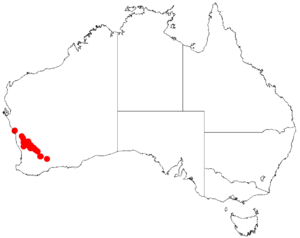Acacia jacksonioides facts for kids
Quick facts for kids Acacia jacksonioides |
|
|---|---|
| Scientific classification | |
| Genus: |
Acacia
|
| Species: |
jacksonioides
|
 |
|
| Occurrence data from AVH | |
Acacia jacksonioides is a type of shrub. It belongs to the Acacia family, which is also known as wattles. This plant only grows naturally in western Australia. This means it is endemic to that area.
Contents
What Does Acacia jacksonioides Look Like?
This shrub is usually dense and bushy. It often has spiny branches. It grows to be about 0.2 to 0.7 metres (0.7 to 2.3 ft) tall. Its branches are short and spread out. They can have a white, powdery coating.
Leaves and Flowers
The leaves of this plant are called phyllodes. They are evergreen, meaning they stay green all year. They can be oval, elliptical, or oblong in shape. Each phyllode is about 3.5 to 10 mm (0.14 to 0.39 in) long. They are also about 2.5 to 5 mm (0.098 to 0.197 in) wide. Each phyllode has a clear line down the middle.
This wattle produces yellow flowers. They bloom from July to August. The flowers grow in small, round clusters. Each cluster has 10 to 14 light golden flowers. These flower-heads are about 3.5 to 4.5 mm (0.14 to 0.18 in) across.
Seed Pods
After the flowers, seed pods grow. These pods are twisted and coiled. They are about 4 cm (1.6 in) long. They are also about 3 mm (0.12 in) wide. Inside the pods are shiny brown seeds. The seeds are oblong and about 2 to 2.5 mm (0.079 to 0.098 in) long. Each seed has a large, fleshy part called an aril.
Where Does Acacia jacksonioides Grow?
This plant is found in the Mid West and Wheatbelt areas of Western Australia. It likes to grow on sandy plains. You can also find it on hills made of laterite rock. It prefers gravelly, sandy, or loamy soils.
Its Natural Habitat
The plant's natural home is spread out. It grows from around Geraldton in the north. It extends south to around Hyden. It is often found in areas with other shrubs. It also grows in Eucalyptus woodlands.

